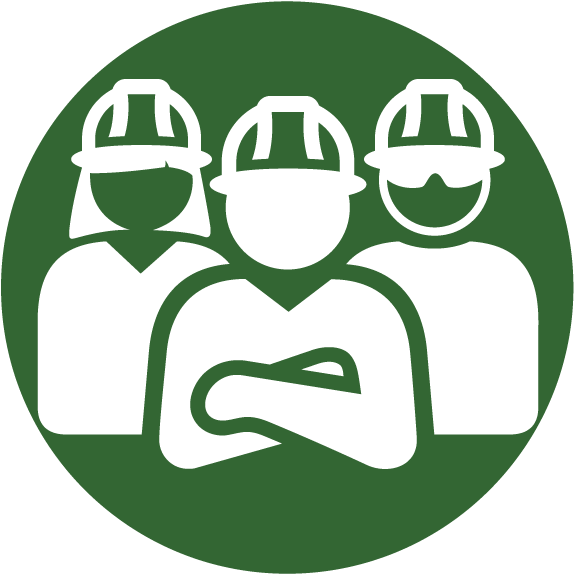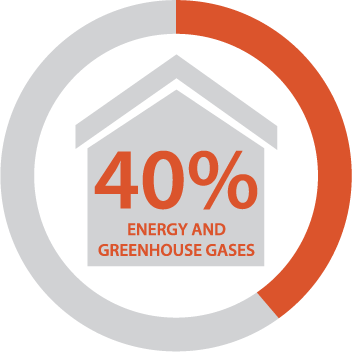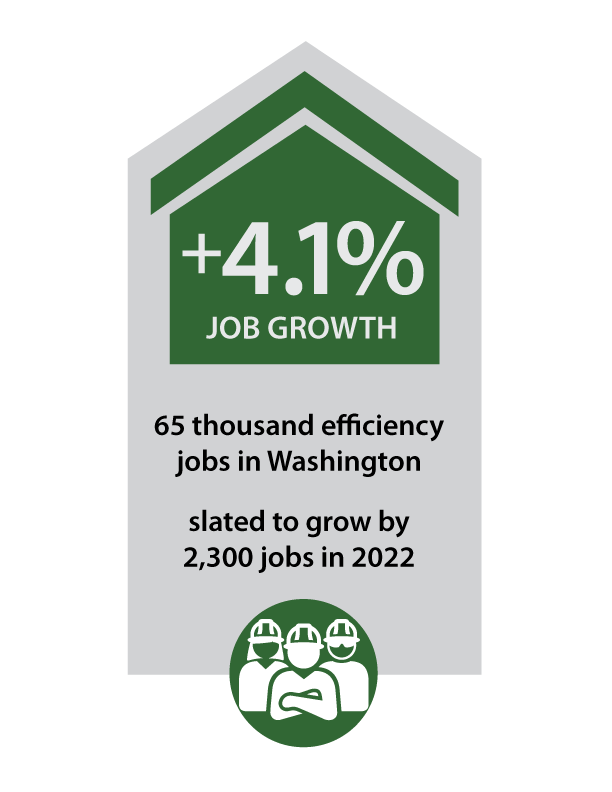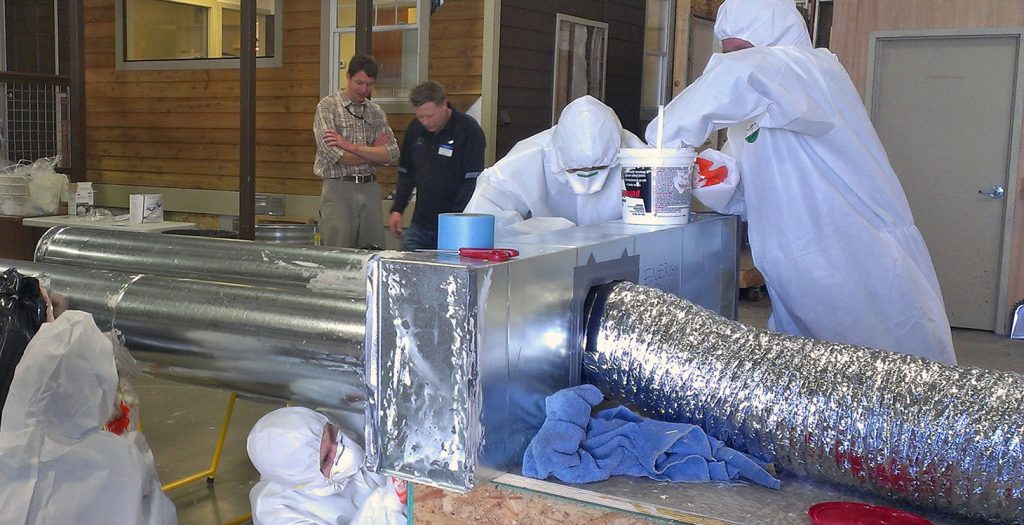crew leader
Becoming a Home Performance Crew Leader
Professional-technical careers that support communities and a clean energy future.

Building Performance Crew Leaders supervise the installation of energy efficiency upgrades, closely monitoring crew performance, work quality, safety, and customer needs. They provide direct, on-site supervision for a team of Building Performance Installers and Energy Efficiency Technicians as they install insulation, energy conservation devices, windows and doors, high-performance heating and hot water systems, and make minor repairs to homes. Crew Leaders may work on single family and multi-family dwellings. This Career Briefer describes the opportunities, pathways and requirements to becoming a skilled residential crew leader.
The Industry
Homes and buildings account for around 40% of all energy used in the U.S. and they generate a similar proportion of greenhouse gas emissions.[1] In the race to drive down energy use and reduce emissions, the home performance industry deploys a wide range of strategies: applying highly-efficient building and home designs; advanced construction and retrofitting techniques; and using energy efficient technology and systems to reduce energy consumption and decrease costs to home owners and renters.
In the U.S. more than 2.3 million people work some or all of their time on building energy efficiency technologies and services.[2] In Washington, there are around 65 thousand efficiency jobs, and the sector is slated to grow by 2,300 jobs in 2022 (4.1%).[3] More than half of all energy efficiency jobs are in construction, where one in every five jobs deal with products and services proven to save energy.
Home performance and efficiency also addresses the need for greater social and economic justice. Providing direct services to improve livability and reduce energy burden for low-income occupants, communities of color and other underserved populations helps reduce the costs to these individuals and families, who typically spend a disproportionate amount of their incomes on home energy. By reducing harmful emissions and improving air quality, home performance projects can also enhance occupant health and safety, and contribute to overall comfort.
The Job
Crew Leaders are responsible for overseeing each job from start to finish and they monitor progress to ensure efficiency and quality. Prior to arriving at a site, a Building Performance Crew Leader reviews a job proposal, establishes the work plan, assigns installers to the crew, and assembles necessary equipment, tools, and materials. Once onsite, the Crew Leader coordinates with the customer, observes safety hazards and establishes safety protocol, maintains accurate inventory of materials and tools, and tracks the crew’s work hours.
Crew Leaders ensure the quality of work performed by team members, and they make sure that material and equipment are installed following state and local codes and to manufacturers’ specifications. Building Performance Crew Leaders usually drive the company work vehicles and are responsible for their care and upkeep. Crew Leaders also provide direct on-the-job training and mentorship to their installers and technicians. They train on the proper handling and installation of materials, how to safely use hand tools, power tools, and equipment, and they model and encourage excellent customer service skills.
In addition to requiring solid leadership skills, technical knowledge and experience, crew leaders interact frequently with others individually and in teams. This may include collaborating on projects with colleagues, energy efficiency contractors and tradespeople such as electricians, plumbers and HVAC specialists. Crew leaders are also a primary contact for building and home-owners and occupants, which means that they must also have good social, listening and problem-solving skills as well as being customer-focused.

Homes and buildings account for around 40% of all energy used in the U.S. and they generate a similar proportion of greenhouse gas emissions.

In Washington, there are around 65 thousand efficiency jobs, and the sector is slated to grow by 2,300 jobs in 2022 (4.1%).

Wage data for Washington shows annual earnings for a weatherization crew leader can range from under $50,000 to $130,000 or above.
Pay and Benefits
Wage data for Washington shows annual earnings for a weatherization crew leader can range from under $50,000 to $130,000 or above, depending on experience, job sector and employer.[4] Recent compensation data for public-sector residential energy auditors in Washington show that crew leaders employed by regional community action agencies that operate low-income weatherization programs earned an average hourly wage of $20.50 ($42,640 annually) in 2021.[5] Regular employees also receive health care and retirement benefits. Crew leader pay and benefits generally increases with experience, and total compensation offered by private-sector employers is often higher than public-sector employers.
Interests and Traits
Crew leaders typically have interests in the social, technical and managerial side of residential weatherization. They are usually organized and like working with others, and operating in a structured environment. They tend to be natural leaders who thrive at coordinating, influencing and motivating others to complete high-quality work within available timelines. They are skillful interpersonal communicators and good listeners, which is valuable because some of their time is spent working directly with clients and other professionals on projects, assisting or coordinating project activities. In addition to planning and coordinating staff, tools, equipment and materials for projects, the actual work happens on-site and includes physical effort and tasks, including the use of specialized equipment and common hand tools, often in tight spaces. In addition to supporting and supervising others, crew leaders also perform technical and physical work while on-site.
Education and Training
Crew leaders have entry points at many different levels of education and experience, but for most employers 3-5 years of related experience, a high school degree or equivalent, and some additional training in a related vocational-technical program, trade apprenticeship or college coursework is usually preferred. Industry certifications such as BPI Building Science Principles, Crew Leader or Site Supervisor certifications are often preferred by employers upon hire, or acquired during employment.[6]

Crew leaders typically have interests in the social, technical and managerial side of residential weatherization.

For experienced crew leaders, multiple career pathways for advancement exist among the different sectors that make up the building and home performance industry.
A highly interactive tool that explores an industry exploding with job opportunities across four major sectors of the green buildings and energy efficiency industry.
Employers
Typical employers of Crew Leaders include government agencies, electric and gas utilities, local non-profit organizations, engineering and environmental consulting firms, property management firms, and thousands of private-sector companies that perform technical work and provide related energy services and administrative support. Home weatherization employers typically work together as part of a network of energy efficiency specialists to provide services across the U.S. and in every region of the state. Washington’s low-income weatherization program, for example, is administered by the state and operates through local governments, non-profit agencies and utility partners, who use federal and state funds to deliver efficiency services to low-income individuals and families who are unable to afford these services on their own. Crew leaders play a key role throughout the weatherization program cycle, especially in planning, organizing, leading and ensuring completion of individual projects.
Career Opportunity and Mobility
It is typical for new crew leaders to begin their careers by working for two to three years as an installer or related technician position, under the supervision of an experienced crew leader. Participation in related training and certification and demonstrated knowledge, skills and leadership abilities during this period can accelerate advancement into a crew leader position. For experienced crew leaders, multiple career pathways for advancement exist among the different sectors that make up the building and home performance industry. That’s because the technical knowledge and skills combined with leadership abilities honed through education, training programs and experience in the workplace are largely transferrable to different sectors and jobs across the industry. The combination of technical and management qualifications are readily applicable to similar roles and advancement in multiple sectors of the green buildings sector, and can also lead to employment with public or private-sector employers, or as a self-employed contractor or consultant.[7]
How to find out more about the home performance industry, the crew leader occupation and related career opportunities:
Resources | Green Buildings Career Map
Building Performance Center – A department of Opportunity Council
Building Performance Institute, Inc. | (bpi.org)
Careers in Green Construction: U.S. Bureau of Labor Statistics (bls.gov)
Explore Careers in Weatherization | Department of Energy
EERE_WAP_Fact-Sheet-v2.pdf (nascsp.org)
Career Maps – Interstate Renewable Energy Council (IREC) (irecusa.org)
[1] In Washington, buildings currently represent approximately one-fifth of state greenhouse gas emissions, mainly from the direct combustion of natural gas and other fossil fuels in buildings for space heating, water heating and cooking. See: WA_2021SES_Chapter-D-Buildings.pdf
[2] See: 2020 U.S. Energy & Employment Report.
[3] See: https://www.energy.gov
[4] Washington Wages: 47-1011.00 – First-Line Supervisors of Construction Trades and Extraction Workers (onetonline.org). Note: These data represent estimated wages for all first-line supervisors of construction trades and extraction workers in the state; the data are not broken out specifically for weatherization crew leaders.
[5] Weatherization Wage Dashboard 2021 | Tableau Public
[6] See: Crew Leader | Building Performance Institute, Inc. (bpi.org). See also: Certification Grid | Building Performance Institute, Inc. (bpi.org)
[7] See: The Green Buildings Career Map, Interstate Renewable Energy Council, Career Maps – Interstate Renewable Energy Council (IREC) (irecusa.org)

